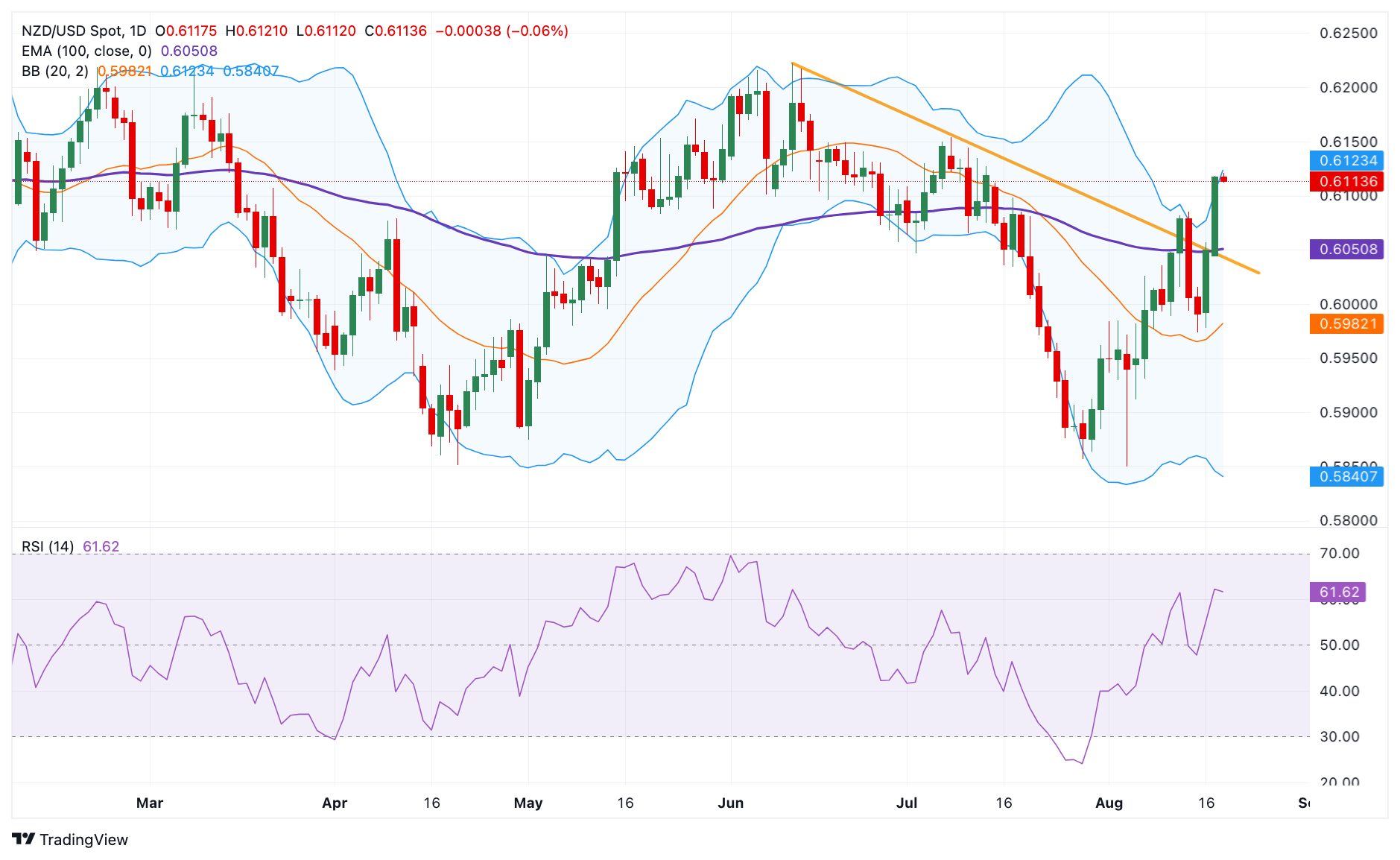- The New Zealand Dollar gains momentum in Tuesday’s Asian session.
- The positive risk sentiment weighs on the US Dollar and lifts NZD/USD.
- The PBoC left the one-year and five-year Loan Prime Rates (LPR) unchanged on Tuesday.
- Investors await the PBoC rate decision ahead of Fedspeak on Tuesday.
The New Zealand Dollar (NZD) trades in positive territory for the third consecutive day on Tuesday. The People’s Bank of China (PBOC) decided to hold the one-year and five-year Loan Prime Rates (LPR) steady on Tuesday at 3.35% and 3.85%, respectively. Any development in the Chinese economy generally impacts Kiwi as China is New Zealand's largest trading partner. Meanwhile, the risk-on sentiment in global markets and easing geopolitical risks in the Middle East continue to undermine the Greenback.
Nonetheless, the dovish remarks from the Reserve Bank of New Zealand (RBNZ) after a surprise rate cut last week might cap the pair’s upside. RBNZ Governor Adrian Orr said on Monday that he is more convinced that inflation has returned to the 1-3% target area, boosting the likelihood of more rate reductions in the future.
Looking ahead, investors will keep an eye on the People’s Bank of China’s (PBoC) Interest Rate Decision, along with the Fed’s Raphael Bostic and Michael Barr speeches on Tuesday. On Friday, New Zealand’s Retail Sales data and Fed Chair Powell's speech at the Jackson Hole symposium will be in the spotlight.
Daily Digest Market Movers: New Zealand Dollar gathers strength amid broad USD weakness
- New Zealand’s Trade Balance came in at NZD $-9.29B YoY in July versus $-9.5B prior, according to the latest data released by Statistics New Zealand on Tuesday.
- New Zealand’s Exports decreased to $6.15B in July versus $6.17B in June whereas Imports rose to $7.11B compared to $5.45B in previous readings.
- Federal Reserve Bank of Minneapolis President Neel Kashkari said on Monday that it was appropriate to discuss potentially cutting US interest rates in September due to concerns about the weakening labor market, per Reuters.
- Chicago Fed President Austan Goolsbee said on Sunday that the US economy does not show signs of overheating, so Fed policymakers should be cautious about keeping restrictive policy in place longer than necessary.
- The markets are now pricing in a nearly 77% chance of a 25 basis points (bps) Fed rate cut in its September meeting, according to the CME FedWatch Tool.
Technical Analysis: New Zealand Dollar resumes its broader bullish trend
The New Zealand Dollar edges higher on the day. The NZD/USD pair resumes its upside journey on the daily chart after breaking above the descending trendline on Monday. Furthermore, the pair holds above the key 100-day Exponential Moving Average (EMA), with the bullish 14-day Relative Strength Index (RSI) above the midline near 62.0, supporting buyers for the time being.
A decisive break above the upper boundary of the Bollinger Band at the 0.6100 psychological level could pave the way to 0.6154, the high of July 8. Further north, the next hurdle emerges at 0.6222, the high of June 12.
On the flip side, the crucial support level for NZD/USD is seen at 0.6050, representing the 100-day EMA and descending trendline. Sustained trading below this level could expose 0.5974, the low of August 15. The next contention level is located at 0.5846, the lower limit of the Bollinger Band.

US Dollar price in the last 7 days
The table below shows the percentage change of US Dollar (USD) against listed major currencies in the last 7 days. US Dollar was the weakest against the Australian Dollar.
| USD | EUR | GBP | CAD | AUD | JPY | NZD | CHF | |
| USD | -1.29% | -1.66% | -0.78% | -2.03% | -0.04% | -1.50% | -0.31% | |
| EUR | 1.28% | -0.35% | 0.51% | -0.77% | 1.24% | -0.20% | 0.96% | |
| GBP | 1.63% | 0.35% | 0.87% | -0.41% | 1.59% | 0.15% | 1.31% | |
| CAD | 0.77% | -0.51% | -0.87% | -1.26% | 0.73% | -0.72% | 0.46% | |
| AUD | 1.99% | 0.76% | 0.41% | 1.27% | 1.99% | 0.56% | 1.71% | |
| JPY | 0.04% | -1.26% | -1.62% | -0.75% | -2.03% | -1.47% | -0.30% | |
| NZD | 1.45% | 0.19% | -0.17% | 0.68% | -0.56% | 1.42% | 1.15% | |
| CHF | 0.30% | -0.95% | -1.32% | -0.45% | -1.74% | 0.30% | -1.18% |
The heat map shows percentage changes of major currencies against each other. The base currency is picked from the left column, while the quote currency is picked from the top row. For example, if you pick the Euro from the left column and move along the horizontal line to the Japanese Yen, the percentage change displayed in the box will represent EUR (base)/JPY (quote).
RBNZ FAQs
The Reserve Bank of New Zealand (RBNZ) is the country’s central bank. Its economic objectives are achieving and maintaining price stability – achieved when inflation, measured by the Consumer Price Index (CPI), falls within the band of between 1% and 3% – and supporting maximum sustainable employment.
The Reserve Bank of New Zealand’s (RBNZ) Monetary Policy Committee (MPC) decides the appropriate level of the Official Cash Rate (OCR) according to its objectives. When inflation is above target, the bank will attempt to tame it by raising its key OCR, making it more expensive for households and businesses to borrow money and thus cooling the economy. Higher interest rates are generally positive for the New Zealand Dollar (NZD) as they lead to higher yields, making the country a more attractive place for investors. On the contrary, lower interest rates tend to weaken NZD.
Employment is important for the Reserve Bank of New Zealand (RBNZ) because a tight labor market can fuel inflation. The RBNZ’s goal of “maximum sustainable employment” is defined as the highest use of labor resources that can be sustained over time without creating an acceleration in inflation. “When employment is at its maximum sustainable level, there will be low and stable inflation. However, if employment is above the maximum sustainable level for too long, it will eventually cause prices to rise more and more quickly, requiring the MPC to raise interest rates to keep inflation under control,” the bank says.
In extreme situations, the Reserve Bank of New Zealand (RBNZ) can enact a monetary policy tool called Quantitative Easing. QE is the process by which the RBNZ prints local currency and uses it to buy assets – usually government or corporate bonds – from banks and other financial institutions with the aim to increase the domestic money supply and spur economic activity. QE usually results in a weaker New Zealand Dollar (NZD). QE is a last resort when simply lowering interest rates is unlikely to achieve the objectives of the central bank. The RBNZ used it during the Covid-19 pandemic.
Information on these pages contains forward-looking statements that involve risks and uncertainties. Markets and instruments profiled on this page are for informational purposes only and should not in any way come across as a recommendation to buy or sell in these assets. You should do your own thorough research before making any investment decisions. FXStreet does not in any way guarantee that this information is free from mistakes, errors, or material misstatements. It also does not guarantee that this information is of a timely nature. Investing in Open Markets involves a great deal of risk, including the loss of all or a portion of your investment, as well as emotional distress. All risks, losses and costs associated with investing, including total loss of principal, are your responsibility. The views and opinions expressed in this article are those of the authors and do not necessarily reflect the official policy or position of FXStreet nor its advertisers. The author will not be held responsible for information that is found at the end of links posted on this page.
If not otherwise explicitly mentioned in the body of the article, at the time of writing, the author has no position in any stock mentioned in this article and no business relationship with any company mentioned. The author has not received compensation for writing this article, other than from FXStreet.
FXStreet and the author do not provide personalized recommendations. The author makes no representations as to the accuracy, completeness, or suitability of this information. FXStreet and the author will not be liable for any errors, omissions or any losses, injuries or damages arising from this information and its display or use. Errors and omissions excepted.
The author and FXStreet are not registered investment advisors and nothing in this article is intended to be investment advice.
Recommended content
Editors’ Picks
AUD/USD turns south toward 0.6700 after PBOC status-quo, RBA Minutes

AUD/USD erases gains to reverse from monthly highs, heading toward 0.6700 in the Asian session on Tuesday. Chinese central bank's inaction coupled with the RBA's less hawkish Minutes check the pair's upside. Markets turn wary amid China woes and ahead of Fedspeak.
USD/JPY extends recovery toward 147.00 despite weaker US Dollar, cautious markets

USD/JPY is extending the recovery toward 147.00 in the Asian trading hours on Tuesday. The pair recovers, notwithstanding a broadly weaker US Dollar and a cautious market mood. Fedspeak is next in focus for fresh trading impetus.
Gold price consolidates in a range around $2,500, bulls not ready to give up yet

Gold price remains confined in a range as bulls await more cues about the Fed’s rate-cut path. Dovish Fed expectations drag the USD to a multi-month low and lend support to the XAU/USD. Hopes for a ceasefire deal in Gaza remain supportive of the upbeat mood and cap the upside.
Ripple price is poised for a rally as on-chain data shows a positive trend

Ripple retested its 200-day Exponential Moving Average and rose 6.7% on Monday. During Asian trading hours, it trades slightly higher by 1.2% at $0.606 on Tuesday.
Betting big on a ‘goldilocks’ scenario for the US economy

The S&P 500 and Nasdaq are riding high, notching their eighth consecutive positive session as stocks continue their winning streak. Investors are pouring back into equities with a renewed sense of ‘full recovery’ confidence, betting big on a ‘Goldilocks’ scenario for the US economy.